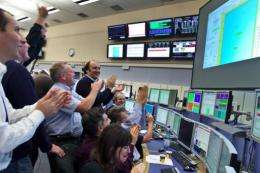CERN to give update on search for Higgs boson

The European Organisation for Nuclear Research said Friday it may announce next month whether tests with its atom-smasher have found the elusive "God particle".
Known formally as the Higgs boson, the particle is the theoretical missing link in the standard model of physics and is believed to be what gives objects mass, though scientists have never been able to pin it down.
The organisation, known as CERN, saids that at a July 4 Geneva conference it will "deliver the latest update in the search for the Higgs boson" it is carrying out with its atom-smasher, the Large Hadron Collider.
The theory behind the so-called God particle is that mass does not derive from particles themselves but instead comes from a boson that interacts strongly with some particles but less, if at all, with others.
"In December we said that there were hints in the data that there may be something there (but) not strong enough to say it's a discovery or not," CERN spokesman James Gillies told AFP by telephone.
"On July 4 we will be able to say whether either there is nothing in the data this year; or there are still hints in the data, but not strong enough for us to be able to say that it is a discovery; and possibly a discovery," he said. "Either of those three things is possible."
The seminar will precede a major physics conference in Melbourne, Australia, where progress in the search for the Higgs boson will be reported.
The Large Hadron Collider, sometimes called the world's largest machine, is located in a 27-kilometre (17-mile) ring-shaped tunnel near Geneva that straddles the Franco-Swiss border up to 175 metres (580 feet) below ground.
It fires streams of protons in opposite, but parallel, directions in the tunnel. The beams are then bent by powerful magnets so that some of the protons collide in four giant labs, which are lined with detectors to record the sub-atomic debris that results.
Data-taking for the Melbourne conference concluded on Monday, CERN's director for accelerators and technology, Steve Myers, said in a statement.
"I'm very much looking forward to seeing what the data reveals."
The agency's research and computing director, Sergio Bertolucci, added there was now twice as much data as last year.
"That should be enough to see whether the trends we were seeing in 2011 data are still there, or whether they've gone away. It is a very exciting time."
If and when a new particle is discovered, scientists will need time to ascertain that it is indeed the Higgs boson, or some other, unknown particle.
(c) 2012 AFP



















